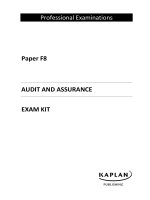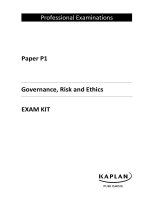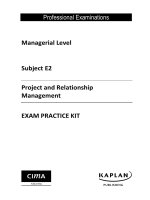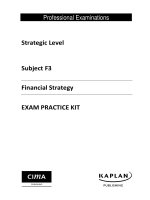ACCA paper e2 project and relatioship exam practice kit
Bạn đang xem bản rút gọn của tài liệu. Xem và tải ngay bản đầy đủ của tài liệu tại đây (231.88 KB, 14 trang )
Professional Examinations
Managerial Level
Subject E2
Project and Relationship
Management
EXAM PRACTICE KIT
SUBJECT E2 : PRO JECT AND RE LA TIONS H IP MANA GEMEN T
Published by: Kaplan Publishing UK
Unit 2 The Business Centre, Molly Millars Lane, Wokingham, Berkshire RG41 2QZ
Copyright © 2017 Kaplan Financial Limited. All rights reserved.
No part of this publication may be reproduced, stored in a retrieval system or transmitted in any
form or by any means electronic, mechanical, photocopying, recording or otherwise without the
prior written permission of the publisher.
Notice
The text in this material and any others made available by any Kaplan Group company does not
amount to advice on a particular matter and should not be taken as such. No reliance should be
placed on the content as the basis for any investment or other decision or in connection with any
advice given to third parties. Please consult your appropriate professional adviser as necessary.
Kaplan Publishing Limited and all other Kaplan group companies expressly disclaim all liability to
any person in respect of any losses or other claims, whether direct, indirect, incidental,
consequential or otherwise arising in relation to the use of such materials.
British Library Cataloguing in Publication Data
A catalogue record for this book is available from the British Library
ISBN: 978-1-78415-933-7
Printed and bound in Great Britain
P.2
CONTENTS
Page
Index to questions and answers
P.4
Examination techniques
P.5
Syllabus guidance, learning objectives and verbs
P.7
Approach to revision
P.11
Section
1
Objective test questions
2
Answers to objective test questions
1
51
Quality and accuracy are of the utmost importance to us so if you spot an error in any of our
products, please send an email to with full details.
Our Quality Co-ordinator will work with our technical team to verify the error and take action to
ensure it is corrected in future editions.
P.3
INDEX TO QUESTIONS AND ANSWERS
OBJECTIVE TEST QUESTIONS
Page number
Question
Answer
1
51
The human aspects of the organisation
17
63
Managing relationships
27
70
Managing change through projects
37
77
Strategic management and the global environment
P.4
EXAM TECHNIQUES
COMPUTER-BASED ASSESSMENT
TEN GOLDEN RULES
1
Make sure you have completed the compulsory 15 minute tutorial before you start exam.
This tutorial is available through the CIMA website. You cannot speak to the invigilator once
you have started.
2
These exam practice kits give you plenty of exam style questions to practise so make sure
you use them to fully prepare.
3
Attempt all questions, there is no negative marking.
4
Double check your answer before you put in the final answer although you can change your
response as many times as you like.
5
On multiple choice questions (MCQs), there is only one correct answer.
6
Not all questions will be MCQs – you may have to fill in missing words or figures.
7
Identify the easy questions first and get some points on the board to build up your
confidence.
8
Try and allow 15 minutes at the end to check your answers and make any corrections.
9
If you don't know the answer, flag the question and attempt it later. In your final review
before the end of the exam try a process of elimination.
10
Work out your answer on the whiteboard provided first if it is easier for you. There is also
an on-screen ‘scratch pad’ on which you can make notes. You are not allowed to take pens,
pencils, rulers, pencil cases, phones, paper or notes.
P.5
S UB J E CT E2 : PRO JECT AND RE LA TIONS H IP MANA GEMEN T
P.6
SYLLABUS GUIDANCE, LEARNING
OBJECTIVES AND VERBS
A AIMS OF THE SYLLABUS
The aims of the syllabus are
•
•
•
to provide for the Institute, together with the practical experience requirements, an
adequate basis for assuring society that those admitted to membership are competent to
act as management accountants for entities, whether in manufacturing, commercial or
service organisations, in the public or private sectors of the economy
to enable the Institute to examine whether prospective members have an adequate
knowledge, understanding and mastery of the stated body of knowledge and skills
to complement the Institute's practical experience and skills development requirements.
B STUDY WEIGHTINGS
A percentage weighting is shown against each topic in the syllabus. This is intended as a guide to
the proportion of study time each topic requires.
All component learning outcomes will be tested and one question may cover more than one
component learning outcome.
The weightings do not specify the number of marks that will be allocated to topics in the
examination.
C LEARNING OUTCOMES
Each topic within the syllabus contains a list of learning outcomes, which should be read in
conjunction with the knowledge content for the syllabus. A learning outcome has two main
purposes:
1
to define the skill or ability that a well-prepared candidate should be able to exhibit in the
examination
2
to demonstrate the approach likely to be taken by examiners in examination questions.
The learning outcomes are part of a hierarchy of learning objectives. The verbs used at the
beginning of each learning outcome relate to a specific learning objective, e.g. Evaluate
alternative approaches to budgeting.
The verb 'evaluate' indicates a high-level learning objective. As learning objectives are
hierarchical, it is expected that at this level students will have knowledge of different budgeting
systems and methodologies and be able to apply them.
A list of the learning objectives and the verbs that appear in the syllabus learning outcomes and
examinations follows and these will help you to understand the depth and breadth required for a
topic and the skill level the topic relates to.
P.7
S UB J E CT E2 : PRO JECT AND RE LA TIONS H IP MANA GEMEN T
Learning objectives
1 Knowledge
What you are expected
to know
Verbs used
Definition
List
State
Make a list of
Express, fully or clearly, the details of/
facts of
Give the exact meaning of
Define
2
Comprehension
What you are expected
to understand
Describe
Distinguish
Explain
Identify
Illustrate
3
Application
How you are expected
to apply your
knowledge
Apply
Calculate/compute
To put to practical use
To ascertain or reckon mathematically
Demonstrate
Solve
Tabulate
To prove with certainty or to exhibit by
practical means
To make or get ready for use
To make or prove consistent/
compatible
Find an answer to
Arrange in a table
Analyse
Categorise
Examine in detail the structure of
Place into a defined class or division
Compare and contrast
Produce
Show the similarities and/or differences
between
To build up or compile
To examine in detail by argument
To translate into intelligible or familiar
terms
To create or bring into existence
Advise
Evaluate
Recommend
Advise
To counsel, inform or notify
To appraise or assess the value of
To advise on a course of action
To counsel, inform or notify
Prepare
Reconcile
4
Analysis
How you are expected
to analyse the detail of
what you have learned
Construct
Discuss
Interpret
5
P.8
Evaluation
How you are expected
to use your learning to
evaluate, make
decisions or
recommendations
Communicate the key features of
Highlight the differences between
Make clear or intelligible/State the
meaning of
Recognise, establish or select after
consideration
Use an example to describe or explain
something
S YLLABUS GUID ANCE , LEAR NING OBJE CTIV ES AND VER BS
D OBJECTIVE TEST
The most common types of Objective Test questions are:
•
multiple choice, where you have to choose the correct answer(s) from a list of possible
answers. This could either be numbers or text.
•
multiple choice with more choices and answers – for example, choosing two correct
answers from a list of eight possible answers. This could either be numbers or text.
•
single numeric entry, where you give your numeric answer e.g. profit is $10,000.
•
multiple entry, where you give several numeric answers e.g. the charge for electricity is
$2000 and the accrual is $200.
•
true/false questions, where you state whether a statement is true or false e.g. external
auditors report to the directors is FALSE.
•
matching pairs of text e.g. the convention 'prudence' would be matched with the
statement' inventories revalued at the lower of cost and net realisable value'.
•
other types could be matching text with graphs and labelling graphs/diagrams.
In this Exam Practice Kit we have used these types of questions.
Some further guidance from CIMA on number entry questions is as follows:
•
For number entry questions, you do not need to include currency symbols or other
characters or symbols such as the percentage sign, as these will have been completed for
you. You may use the decimal point but must not use any other characters when entering
an answer (except numbers) so, for example, $10,500.80 would be input as 10500.80
•
When expressing a decimal, for example a probability or correlation coefficient, you should
include the leading zero (i.e. you should input 0.5 not .5)
•
Negative numbers should be input using the minus sign, for example –1000
•
You will receive an error message if you try to enter a character or symbol that is not
permitted (for example a ‘£’ or ‘%’ sign)
•
A small range of answers will normally be accepted, taking into account sensible rounding
Guidance re CIMA On-Screen calculator:
As part of the computer based assessment software, candidates are now provided with a
calculator. This calculator is on-screen and is available for the duration of the assessment. The
calculator is accessed by clicking the calculator button in the top left hand corner of the screen at
any time during the assessment.
All candidates must complete a 15 minute tutorial before the assessment begins and will have the
opportunity to familiarise themselves with the calculator and practise using it.
Candidates may practise using the calculator by downloading and installing the practice exam at
The calculator can be accessed from the fourth sample question
(of 12).
Please note that the practice exam and tutorial provided by Pearson VUE at
is not specific to CIMA and includes the full range of question types
the Pearson VUE software supports, some of which CIMA does not currently use.
P.9
S UB J E CT E2 : PRO JECT AND RE LA TIONS H IP MANA GEMEN T
The Objective Tests are ninety minute computer-based assessments comprising 60 compulsory
questions, with one or more parts. CIMA is continuously developing the question styles within the
system and you are advised to try the online website demo at www.cimaglobal.com, to both gain
familiarity with assessment software and examine the latest style of questions being used.
P.10
Section 1
OBJECTIVE TEST QUESTIONS
STRATEGIC MANAGEMENT AND THE GLOBAL ENVIRONMENT
1
2
3
According to Drucker, there are five fundamental questions which organisations should
consider when setting its strategy. Which of the following are Drucker’s fundamental
questions? Select all that apply.
A
What is our mission?
B
How will we compete in our chosen industry?
C
What is valued by our customer?
D
What is our plan?
E
What should our business be?
F
What is our vision?
Those things which must go right if the objectives and goals of an organisation are to be
achieved are known as which of the following?
A
Key performance indicators
B
Performance targets
C
Operational objectives
D
Critical success factors
Which of the following are techniques suggested by Cyert and March for resolving
stakeholder conflict? Select all that apply.
A
Sequential attention
B
Keep informed
C
Weighting and scoring
D
Satisficing
E
Side payments
F
Prioritisation
1
S UB J E CT E2 : P ROJE C T AND RE LA TIONS H IP MANA GEMEN T
4
5
Cultural or demographic factors would generally be considered under which heading in
the PESTLE framework?
•
Political
•
Economic
•
Social
•
Technological
•
Legal
•
Environmental
The following diagram depicting the rational/formal model of strategy formulation has
several gaps.
Set mission
Corporate appraisal
(SWOT)
Strategy evaluation
and choice
Strategy
implementation
Review and control
Complete the gaps by dragging the correct word to the correct place on the diagram.
2
External analysis
Stakeholder analysis
Internal analysis
Establish objectives
Generate strategy options
Competitor review
OBJE CTIVE TEST QUESTIONS : SECTION 1
6
K is a successful entrepreneur. He is considering entering a new market which he considers
will generate profits of over $30,000 per annum. He has discovered that to set up the new
business he would have to purchase a machine costing $18,000, purchase a licence costing
$3,000 and attend an intensive two day training course.
Which of the following situations would Porter’s five forces model suggest?
The power of the supplier is low
B
Rivalry is high
C
The threat of new entrants is high
D
The power of buyers is low
Ansoff’s matrix suggests the following four alternatives which organisations can adopt
when considering strategic direction.
Market penetration
Product development
Diversification
Market development
Complete Ansoff’s Matrix by placing the correct strategy in the correct space on the
matrix.
Product
New
New
Current
Current
Market
7
A
3
S UB J E CT E2 : P ROJE C T AND RE LA TIONS H IP MANA GEMEN T
8
PQR manufactures cardboard packaging. It is considering moving into the plastic packaging
market. It has established that there are four main plastic packaging manufacturers, who
have an aggregate market share of 82%. The current market leader has a share of 26%. The
four companies produce products of similar size and quality. The market for plastic
packaging has grown by 2% per annum in recent years.
Identify which aspect of Porter’s five forces would consider this information and identify
if the scenario suggests that the force would be high or low.
New entrant
Low
Power of buyer
High
Power of supplier
Substitutes
Rivalry
The force which would consider this information is ___________and from the scenario, the
force would be __________.
9
10
There are four main ways in which an organisation can react to environmental situations.
Where an organisation recognises an environmental problem but has decided it will be
insignificant and have a short-term implication, its likely reaction would be:
A
Introduce internal controls
B
Plan major strategic change
C
Do nothing
D
Increase its flexibility
ABC is considering making 200 of their 3,000 employees redundant. Only around 2% of
ABC’s workers are members of a union. Select the most appropriate management
strategy for the employees and place it in the correct area of the Mendelow matrix.
low
low
interest
high
Keep informed
Keep satisfied
power
Key players
Minimal effort
high
4









